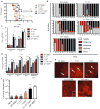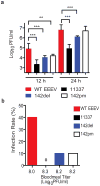RNA viruses can hijack vertebrate microRNAs to suppress innate immunity
- PMID: 24352241
- PMCID: PMC4349380
- DOI: 10.1038/nature12869
RNA viruses can hijack vertebrate microRNAs to suppress innate immunity
Abstract
Currently, there is little evidence for a notable role of the vertebrate microRNA (miRNA) system in the pathogenesis of RNA viruses. This is primarily attributed to the ease with which these viruses mutate to disrupt recognition and growth suppression by host miRNAs. Here we report that the haematopoietic-cell-specific miRNA miR-142-3p potently restricts the replication of the mosquito-borne North American eastern equine encephalitis virus in myeloid-lineage cells by binding to sites in the 3' non-translated region of its RNA genome. However, by limiting myeloid cell tropism and consequent innate immunity induction, this restriction directly promotes neurologic disease manifestations characteristic of eastern equine encephalitis virus infection in humans. Furthermore, the region containing the miR-142-3p binding sites is essential for efficient virus infection of mosquito vectors. We propose that RNA viruses can adapt to use antiviral properties of vertebrate miRNAs to limit replication in particular cell types and that this restriction can lead to exacerbation of disease severity.
Figures











Similar articles
-
Cooperativity between the 3' untranslated region microRNA binding sites is critical for the virulence of eastern equine encephalitis virus.PLoS Pathog. 2019 Oct 28;15(10):e1007867. doi: 10.1371/journal.ppat.1007867. eCollection 2019 Oct. PLoS Pathog. 2019. PMID: 31658290 Free PMC article.
-
Identification of cellular microRNA-136 as a dual regulator of RIG-I-mediated innate immunity that antagonizes H5N1 IAV replication in A549 cells.Sci Rep. 2015 Oct 9;5:14991. doi: 10.1038/srep14991. Sci Rep. 2015. PMID: 26450567 Free PMC article.
-
Inducible MicroRNA-3570 Feedback Inhibits the RIG-I-Dependent Innate Immune Response to Rhabdovirus in Teleost Fish by Targeting MAVS/IPS-1.J Virol. 2018 Jan 2;92(2):e01594-17. doi: 10.1128/JVI.01594-17. Print 2018 Jan 15. J Virol. 2018. PMID: 29093090 Free PMC article.
-
Alphaviruses suppress host immunity by preventing myeloid cell replication and antagonizing innate immune responses.Curr Opin Virol. 2017 Apr;23:30-34. doi: 10.1016/j.coviro.2017.02.004. Epub 2017 Mar 10. Curr Opin Virol. 2017. PMID: 28288385 Free PMC article. Review.
-
Role of Viral and Host microRNAs in Immune Regulation of Epstein-Barr Virus-Associated Diseases.Front Immunol. 2020 Mar 3;11:367. doi: 10.3389/fimmu.2020.00367. eCollection 2020. Front Immunol. 2020. PMID: 32194570 Free PMC article. Review.
Cited by
-
Difference in microRNA expression and editing profile of lung tissues from different pig breeds related to immune responses to HP-PRRSV.Sci Rep. 2015 Apr 9;5:9549. doi: 10.1038/srep09549. Sci Rep. 2015. PMID: 25856272 Free PMC article.
-
Cryo-EM Structures of Eastern Equine Encephalitis Virus Reveal Mechanisms of Virus Disassembly and Antibody Neutralization.Cell Rep. 2018 Dec 11;25(11):3136-3147.e5. doi: 10.1016/j.celrep.2018.11.067. Cell Rep. 2018. PMID: 30540945 Free PMC article.
-
On the Importance of Host MicroRNAs During Viral Infection.Front Genet. 2018 Oct 2;9:439. doi: 10.3389/fgene.2018.00439. eCollection 2018. Front Genet. 2018. PMID: 30333857 Free PMC article. Review.
-
Immune-related miRNA-mRNA regulation network in the livers of DHAV-3-infected ducklings.BMC Genomics. 2020 Feb 4;21(1):123. doi: 10.1186/s12864-020-6539-7. BMC Genomics. 2020. PMID: 32019511 Free PMC article.
-
microRNAs, the Link Between Dengue Virus and the Host Genome.Front Microbiol. 2021 Aug 11;12:714409. doi: 10.3389/fmicb.2021.714409. eCollection 2021. Front Microbiol. 2021. PMID: 34456895 Free PMC article. Review.
References
Publication types
MeSH terms
Substances
Grants and funding
LinkOut - more resources
Full Text Sources
Other Literature Sources
Molecular Biology Databases

